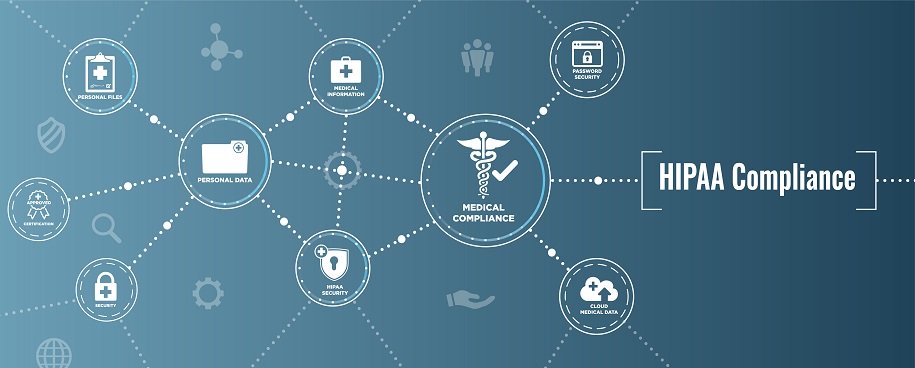
Health Insurance Profitability and Accountability Act (HIPAA) is the core law governing the management, storage and transmission of protected health information (PHI), which came into existence in 1996.The HIPAA Privacy Rule and the HIPAA Security Rule help standardize and safeguard the flow of PHI, for better organizational functionality.
- The HIPAA Privacy Rule, or the Standards for Privacy of Individually Identifiable Health Information, establishes national standards to protect medical records and other personal health information transferred in electronic form.
- The HIPAA Security Rule, or Security Standards for the Protection of Electronic Protected Health Information, establishes national standards to protect electronic personal health information that is created, received, used, or maintained by a covered entity.
With a vast experience in the healthcare digitalization industry, Vatsa Solutions has worked closely with medical and healthcare companies to build websites and applications following medical standards like HIPAA, HL7 and Mirth connect (also called NextGen Connect). (See how Vatsa created a HL7 standard-based healthcare platform for simplified pre-operative care and better surgery outcomes.) Sharing or tracking medical and health records through electronic mediums like websites and mobile applications comes with challenges, as well as safety concerns. HIPAA standards lay down guidelines for the same.
In September 2013, HIPAA’s Final Omnibus Rule Update was passed. Before the amendment, only covered entities i.e. doctors, hospitals, and insurers, were required to comply with HIPAA rules. This amendment expands the definition of the entities, who are required to be HIPAA compliant, to all entities dealing with storage, management, recording and passing Protected Health Information (PHI).
Listed below are the key deliverables to make websites and applications HIPAA compliant.
1. SSL (Secure Sockets Layer) Protection
The SSL protection is a networking protocol that includes authentic and encrypted communication between a web server and browser. In simple terms, it means that whenever a person browses through a website or logs into an account, all data is safely encrypted at all times. The information is protected from theft and third-party interception. Should anyone steal it, they would not be able to decode it.
2. Full Data Backup and Encryption
Backup and encryption of stored data is to make sure that all essential data, including PHI, is not lost in case of any unexpected occurrence. In the event of a system failure, data remains safe and can be restored. Encryption of stored data ensures that all backup remains secure.
3. Permanent Data Deletion
All HIPAA compliant websites are required to delete all data that is no longer relevant to the company’s business, ‘permanently’. Customers, who are no more your customers, are ‘no more relevant’ to your company; so their data needs to be permanently deleted from your records, with no recourse to retrieving it, in any way.
4. Restricted Access
Only users can access their data and they can access only their data (and not any other data). Along with this, clearly authorised administrators from company can access the website and make changes to it. How many changes, minor or major, how frequently – all these parameters are driven by HIPAA. A slightly out-of-place or misinformed change could mean a breach of HIPAA and lead to serious consequences. Companies need to be alert to these requirements.
5. Data Breach Protocol
Where there is data, there must be a data breach protocol in place. This is to provide for any such eventuality that might happen. Having such protocols ensures that the organization is prepared for any contingency and should the breach take place, it can be quickly dealt with, without too much damage to the data, the reputation and the trust of the company.
6. HIPAA Business Associate Agreement with Site Host
A HIPAA-compliant website involves a lot of work and needs far more security than a regular non-compliant website. The site host must be informed and one must have an agreement with them for HIPAA compliance, so that both parties are aligned on the implementation, rules and cost fronts. This applies to all vendors, who need to be aligned on HIPAA compliance.
Being HIPAA compliant tells your users that you adhere to the law and you respect their rights of privacy. It builds trust in an industry that is fast becoming competitive. It makes users stick to your company knowing that their information is valued and secure.
Healthcare communication systems require great care and caution to see that you stay breach-free. Having a clean HIPAA compliant website and app is a great way to stay so. Vatsa Solutions has helped many health and medical organizations to make HIPAA compliant websites and mobile apps. To know more on how you can make your website HIPAA compliant, connect with us at contact@vsplc.com or simply fill out the contact form and we will get in touch.
Check out our success with Mirth Connect implementation for interoperability between EHR and EMR systems.





